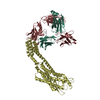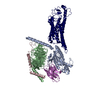+ データを開く
データを開く
- 基本情報
基本情報
| 登録情報 | データベース: PDB / ID: 8j9n | |||||||||||||||||||||||||||||||||||||||||||||
|---|---|---|---|---|---|---|---|---|---|---|---|---|---|---|---|---|---|---|---|---|---|---|---|---|---|---|---|---|---|---|---|---|---|---|---|---|---|---|---|---|---|---|---|---|---|---|
| タイトル | Gq bound FZD1 in ligand-free state | |||||||||||||||||||||||||||||||||||||||||||||
 要素 要素 |
| |||||||||||||||||||||||||||||||||||||||||||||
 キーワード キーワード | MEMBRANE PROTEIN / FZD1-Gq / class-F / Frizzled receptor / Complex | |||||||||||||||||||||||||||||||||||||||||||||
| 機能・相同性 |  機能・相同性情報 機能・相同性情報muscular septum morphogenesis / regulation of mesenchymal stem cell differentiation / autocrine signaling / astrocyte-dopaminergic neuron signaling / Fatty Acids bound to GPR40 (FFAR1) regulate insulin secretion / Acetylcholine regulates insulin secretion / presynapse assembly / phospholipase C-activating G protein-coupled glutamate receptor signaling pathway / Wnt receptor activity / non-canonical Wnt signaling pathway ...muscular septum morphogenesis / regulation of mesenchymal stem cell differentiation / autocrine signaling / astrocyte-dopaminergic neuron signaling / Fatty Acids bound to GPR40 (FFAR1) regulate insulin secretion / Acetylcholine regulates insulin secretion / presynapse assembly / phospholipase C-activating G protein-coupled glutamate receptor signaling pathway / Wnt receptor activity / non-canonical Wnt signaling pathway / membranous septum morphogenesis / endothelial cell differentiation / phospholipase C-activating serotonin receptor signaling pathway / PLC beta mediated events / Wnt-protein binding / regulation of platelet activation / entrainment of circadian clock / midbrain dopaminergic neuron differentiation / hard palate development / frizzled binding / negative regulation of oxidative stress-induced neuron intrinsic apoptotic signaling pathway / PCP/CE pathway / Class B/2 (Secretin family receptors) / Wnt signalosome / regulation of canonical Wnt signaling pathway / Disassembly of the destruction complex and recruitment of AXIN to the membrane / glutamate receptor signaling pathway / outflow tract morphogenesis / phototransduction, visible light / PKA activation in glucagon signalling / developmental growth / hair follicle placode formation / negative regulation of BMP signaling pathway / photoreceptor outer segment / canonical Wnt signaling pathway / D1 dopamine receptor binding / regulation of presynapse assembly / positive regulation of osteoblast differentiation / neuropeptide signaling pathway / intracellular transport / postsynaptic cytosol / vascular endothelial cell response to laminar fluid shear stress / renal water homeostasis / activation of adenylate cyclase activity / Hedgehog 'off' state / adenylate cyclase-activating adrenergic receptor signaling pathway / enzyme regulator activity / response to prostaglandin E / cellular response to glucagon stimulus / regulation of insulin secretion / GTPase activator activity / adenylate cyclase activator activity / Turbulent (oscillatory, disturbed) flow shear stress activates signaling by PIEZO1 and integrins in endothelial cells / trans-Golgi network membrane / TCF dependent signaling in response to WNT / Asymmetric localization of PCP proteins / PDZ domain binding / negative regulation of inflammatory response to antigenic stimulus / negative regulation of canonical Wnt signaling pathway / positive regulation of neuron projection development / G protein-coupled receptor binding / bone development / G protein-coupled receptor activity / platelet aggregation / cognition / G-protein beta/gamma-subunit complex binding / adenylate cyclase-activating G protein-coupled receptor signaling pathway / Olfactory Signaling Pathway / Activation of the phototransduction cascade / neuron differentiation / G beta:gamma signalling through PLC beta / Presynaptic function of Kainate receptors / Thromboxane signalling through TP receptor / G protein-coupled acetylcholine receptor signaling pathway / Activation of G protein gated Potassium channels / Inhibition of voltage gated Ca2+ channels via Gbeta/gamma subunits / G-protein activation / Prostacyclin signalling through prostacyclin receptor / G beta:gamma signalling through CDC42 / blood coagulation / Glucagon signaling in metabolic regulation / G beta:gamma signalling through BTK / Synthesis, secretion, and inactivation of Glucagon-like Peptide-1 (GLP-1) / ADP signalling through P2Y purinoceptor 12 / photoreceptor disc membrane / Sensory perception of sweet, bitter, and umami (glutamate) taste / Glucagon-type ligand receptors / Adrenaline,noradrenaline inhibits insulin secretion / Vasopressin regulates renal water homeostasis via Aquaporins / sensory perception of smell / Glucagon-like Peptide-1 (GLP1) regulates insulin secretion / G alpha (z) signalling events / cellular response to catecholamine stimulus / ADORA2B mediated anti-inflammatory cytokines production / ADP signalling through P2Y purinoceptor 1 / G beta:gamma signalling through PI3Kgamma / Cooperation of PDCL (PhLP1) and TRiC/CCT in G-protein beta folding / adenylate cyclase-activating dopamine receptor signaling pathway / cell-cell signaling / GPER1 signaling 類似検索 - 分子機能 | |||||||||||||||||||||||||||||||||||||||||||||
| 生物種 |  Homo sapiens (ヒト) Homo sapiens (ヒト) | |||||||||||||||||||||||||||||||||||||||||||||
| 手法 | 電子顕微鏡法 / 単粒子再構成法 / クライオ電子顕微鏡法 / 解像度: 3.5 Å | |||||||||||||||||||||||||||||||||||||||||||||
 データ登録者 データ登録者 | Lin, X. / Xu, F. | |||||||||||||||||||||||||||||||||||||||||||||
| 資金援助 | 1件
| |||||||||||||||||||||||||||||||||||||||||||||
 引用 引用 |  ジャーナル: Cell Discov / 年: 2024 ジャーナル: Cell Discov / 年: 2024タイトル: A framework for Frizzled-G protein coupling and implications to the PCP signaling pathways. 著者: Zhibin Zhang / Xi Lin / Ling Wei / Yiran Wu / Lu Xu / Lijie Wu / Xiaohu Wei / Suwen Zhao / Xiangjia Zhu / Fei Xu /  要旨: The ten Frizzled receptors (FZDs) are essential in Wnt signaling and play important roles in embryonic development and tumorigenesis. Among these, FZD6 is closely associated with lens development. ...The ten Frizzled receptors (FZDs) are essential in Wnt signaling and play important roles in embryonic development and tumorigenesis. Among these, FZD6 is closely associated with lens development. Understanding FZD activation mechanism is key to unlock these emerging targets. Here we present the cryo-EM structures of FZD6 and FZD3 which are known to relay non-canonical planar cell polarity (PCP) signaling pathways as well as FZD1 in their G protein-coupled states and in the apo inactive states, respectively. Comparison of the three inactive/active pairs unveiled a shared activation framework among all ten FZDs. Mutagenesis along with imaging and functional analysis on the human lens epithelial tissues suggested potential crosstalk between the G-protein coupling of FZD6 and the PCP signaling pathways. Together, this study provides an integrated understanding of FZD structure and function, and lays the foundation for developing therapeutic modulators to activate or inhibit FZD signaling for a range of disorders including cancers and cataracts. | |||||||||||||||||||||||||||||||||||||||||||||
| 履歴 |
|
- 構造の表示
構造の表示
| 構造ビューア | 分子:  Molmil Molmil Jmol/JSmol Jmol/JSmol |
|---|
- ダウンロードとリンク
ダウンロードとリンク
- ダウンロード
ダウンロード
| PDBx/mmCIF形式 |  8j9n.cif.gz 8j9n.cif.gz | 209.7 KB | 表示 |  PDBx/mmCIF形式 PDBx/mmCIF形式 |
|---|---|---|---|---|
| PDB形式 |  pdb8j9n.ent.gz pdb8j9n.ent.gz | 158.7 KB | 表示 |  PDB形式 PDB形式 |
| PDBx/mmJSON形式 |  8j9n.json.gz 8j9n.json.gz | ツリー表示 |  PDBx/mmJSON形式 PDBx/mmJSON形式 | |
| その他 |  その他のダウンロード その他のダウンロード |
-検証レポート
| 文書・要旨 |  8j9n_validation.pdf.gz 8j9n_validation.pdf.gz | 1.1 MB | 表示 |  wwPDB検証レポート wwPDB検証レポート |
|---|---|---|---|---|
| 文書・詳細版 |  8j9n_full_validation.pdf.gz 8j9n_full_validation.pdf.gz | 1.1 MB | 表示 | |
| XML形式データ |  8j9n_validation.xml.gz 8j9n_validation.xml.gz | 43.2 KB | 表示 | |
| CIF形式データ |  8j9n_validation.cif.gz 8j9n_validation.cif.gz | 65.9 KB | 表示 | |
| アーカイブディレクトリ |  https://data.pdbj.org/pub/pdb/validation_reports/j9/8j9n https://data.pdbj.org/pub/pdb/validation_reports/j9/8j9n ftp://data.pdbj.org/pub/pdb/validation_reports/j9/8j9n ftp://data.pdbj.org/pub/pdb/validation_reports/j9/8j9n | HTTPS FTP |
-関連構造データ
| 関連構造データ |  36111MC  8j9oC  8jh7C  8jhbC  8jhcC  8jhiC M: このデータのモデリングに利用したマップデータ C: 同じ文献を引用 ( |
|---|---|
| 類似構造データ | 類似検索 - 機能・相同性  F&H 検索 F&H 検索 |
- リンク
リンク
- 集合体
集合体
| 登録構造単位 | 
|
|---|---|
| 1 |
|
- 要素
要素
| #1: タンパク質 | 分子量: 64015.668 Da / 分子数: 1 / 由来タイプ: 組換発現 / 由来: (組換発現)  Homo sapiens (ヒト) / 遺伝子: FZD1 / 細胞株 (発現宿主): SF9 Homo sapiens (ヒト) / 遺伝子: FZD1 / 細胞株 (発現宿主): SF9発現宿主:  参照: UniProt: Q9UP38 |
|---|---|
| #2: タンパク質 | 分子量: 28820.500 Da / 分子数: 1 / Mutation: G49D,E50N,A249D,S252D,I372A,V375I / 由来タイプ: 組換発現 / 詳細: Chimeric protein MiniGQ / 由来: (組換発現)  Homo sapiens (ヒト) / 遺伝子: GNAS, GNAS1, GSP, GNAQ, GAQ / 発現宿主: Homo sapiens (ヒト) / 遺伝子: GNAS, GNAS1, GSP, GNAQ, GAQ / 発現宿主:  |
| #3: タンパク質 | 分子量: 37416.930 Da / 分子数: 1 / 由来タイプ: 組換発現 / 由来: (組換発現)  Homo sapiens (ヒト) / 遺伝子: GNB1 / 細胞株 (発現宿主): Hi5 / 発現宿主: Homo sapiens (ヒト) / 遺伝子: GNB1 / 細胞株 (発現宿主): Hi5 / 発現宿主:  Trichoplusia ni (イラクサキンウワバ) / 参照: UniProt: P62873 Trichoplusia ni (イラクサキンウワバ) / 参照: UniProt: P62873 |
| #4: タンパク質 | 分子量: 7845.078 Da / 分子数: 1 / Mutation: C68S / 由来タイプ: 組換発現 / 由来: (組換発現)  Homo sapiens (ヒト) / 遺伝子: GNG2 / 細胞株 (発現宿主): Hi5 / 発現宿主: Homo sapiens (ヒト) / 遺伝子: GNG2 / 細胞株 (発現宿主): Hi5 / 発現宿主:  Trichoplusia ni (イラクサキンウワバ) / 参照: UniProt: P59768 Trichoplusia ni (イラクサキンウワバ) / 参照: UniProt: P59768 |
| #5: 抗体 | 分子量: 16054.232 Da / 分子数: 1 / 由来タイプ: 組換発現 / 由来: (組換発現)   |
| Has protein modification | Y |
-実験情報
-実験
| 実験 | 手法: 電子顕微鏡法 |
|---|---|
| EM実験 | 試料の集合状態: PARTICLE / 3次元再構成法: 単粒子再構成法 |
- 試料調製
試料調製
| 構成要素 | 名称: FZD1-Gq complex in the ligand-free state / タイプ: COMPLEX / Entity ID: all / 由来: RECOMBINANT | ||||||||||||||||
|---|---|---|---|---|---|---|---|---|---|---|---|---|---|---|---|---|---|
| 由来(天然) |
| ||||||||||||||||
| 由来(組換発現) |
| ||||||||||||||||
| 緩衝液 | pH: 7.5 | ||||||||||||||||
| 試料 | 包埋: NO / シャドウイング: NO / 染色: NO / 凍結: YES | ||||||||||||||||
| 急速凍結 | 凍結剤: ETHANE |
- 電子顕微鏡撮影
電子顕微鏡撮影
| 実験機器 |  モデル: Titan Krios / 画像提供: FEI Company |
|---|---|
| 顕微鏡 | モデル: FEI TITAN KRIOS |
| 電子銃 | 電子線源: OTHER / 加速電圧: 300 kV / 照射モード: OTHER |
| 電子レンズ | モード: OTHER / 最大 デフォーカス(公称値): 2200 nm / 最小 デフォーカス(公称値): 700 nm |
| 撮影 | 電子線照射量: 60 e/Å2 / フィルム・検出器のモデル: GATAN K3 (6k x 4k) |
- 解析
解析
| EMソフトウェア | 名称: PHENIX / カテゴリ: モデル精密化 | ||||||||||||||||||||||||
|---|---|---|---|---|---|---|---|---|---|---|---|---|---|---|---|---|---|---|---|---|---|---|---|---|---|
| CTF補正 | タイプ: NONE | ||||||||||||||||||||||||
| 3次元再構成 | 解像度: 3.5 Å / 解像度の算出法: FSC 0.143 CUT-OFF / 粒子像の数: 544329 / 対称性のタイプ: POINT | ||||||||||||||||||||||||
| 拘束条件 |
|
 ムービー
ムービー コントローラー
コントローラー








 PDBj
PDBj























 microscopy
microscopy